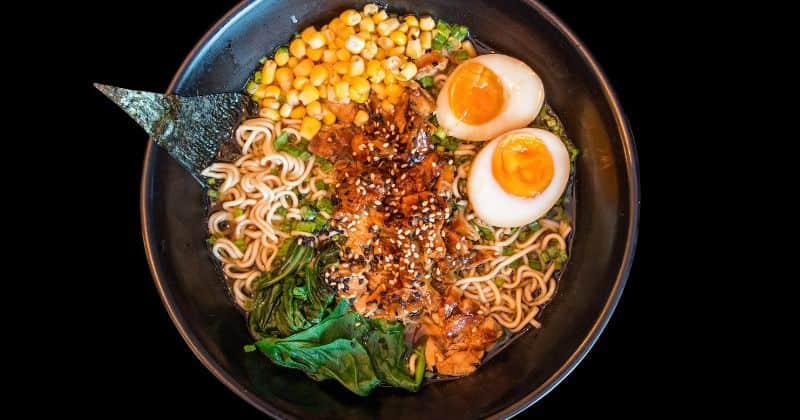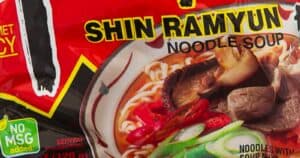Adding that savory ramen seasoning packet is the final step to a perfect bowl of noodles. But should you sprinkle it on before or after cooking for optimal flavor? This debate has raged on for ages in the ramen fanbase.
The case for before focuses on infusing flavor throughout, while after allows customization. So which method is better? The answer depends on your priorities:
- For simplicity, add seasoning before cooking so the flavor blends into the noodles and broth.
- For flexibility, add after cooking so you can control the flavor precisely.
- For tender noodles, before lightly seasons as they cook.
- For firmer texture, after keeps them from getting soggy.
While ramen traditionalists insist on adding seasoning before, both methods have their perks. Follow package guidance, then tweak to your personal taste. Read on for step-by-step instructions to flawlessly season ramen noodles, before or after cooking.
The Case for Adding Ramen Seasoning Before Cooking
Adding ramen seasoning before cooking allows the flavor to really permeate the noodles and broth. The seasoning blends into the ingredients, creating a more intense and nuanced taste.
Flavor Infusion
When added before cooking, the seasoning has time to infuse into the noodles, broth, and any other ingredients. This gives you a much deeper, more complex flavor that coats each noodle.
Prevent Sticking
Sprinkling on the seasoning first creates a light coating on the noodles that helps prevent them from sticking together as they cook. No more clumps of noodles!
Richer broth
With seasoning blended in from the start, the broth takes on extra depth of flavor for a mouthwatering slurp.
Shorter Cooking Time
Adding seasoning first means you can throw everything in together and cook in one step, saving you time and dishes.
Tender Noodles
The salt interacts with the noodles to soften them and impart tenderness, improving the overall texture.
Best for Simplicity
If you’re eating the ramen on its own without many added ingredients, seasoning first gives the most flavor.
The Case for Adding Ramen Seasoning After Cooking
On the other hand, holding off on adding seasoning until after cooking has some advantages as well. It gives you more control over the flavor.
Customize Flavor
You can taste test the noodles and broth before seasoning, then adjust to your preferred
Maintain Texture
The noodles won’t over soak up seasoning and become mushy, instead keeping an springy, al dente texture.
Versatility
Add other flavor components like miso, soy sauce, chili crisp oil, or hot sauce without worrying about over-seasoning.
Avoid Sogginess
The dry seasoning avoids making the noodles soggy, especially if letting them sit for a few minutes after cooking.
Ideal For Additions
If you’ll be adding lots of vegetables, eggs, meat etc., it’s best to season after so you can complement those flavors.
Prevent Over-Seasoning
It’s easier to control amount and avoid too much salt or
So When Should You Add the Flavor Packet to Ramen?
Given the good arguments on both sides, when should you add the seasoning packet – before or after cooking? Here are some tips to decide:
For simplicity, add it before
If you’re preparing a basic ramen with just noodles and broth, adding seasoning before optimizes flavor infusion.
For customization, add it after
If you want to tweak flavors or add other ingredients, seasoning after gives you more control.
For texture, it depends
Before helps tenderize noodles but can make them mushy if over-seasoned. After preserves texture better.
For food safety, it’s fine either way
As long as the noodles reach a full boil, adding seasoning before vs after makes no difference food safety-wise.
For convenience, do both!
Consider keeping some seasoned noodles in the pantry for quick meals, and seasoning others dishes later for more customization.
The beauty of ramen is that there are no hard rules – season to your taste! Follow package directions first, then adjust the method to your own preferences.
Step-By-Step Guide for Perfectly Seasoned Ramen
Now that you know the when, here is a how-to guide to seasoning ramen noodles flawlessly, no matter which method you choose:
Before Cooking
If adding seasoning before cooking:
- Read package instructions carefully and prepare any broth.
- Place dry noodles in pot with broth and any vegetables or proteins.
- Sprinkle entire seasoning packet over noodles.
- Bring to a boil over high heat, stirring occasionally.
- Once boiling, reduce heat and simmer for 3 minutes, or according to package time.
After Cooking
If seasoning after cooking:
- Prepare noodles and broth according to package instructions.
- Once cooked, drain noodles and reserve broth in a bowl or pot.
- Taste a few noodles and the broth. Determine if you want more/less salt and
spice . - Add a portion of the seasoning packet to the noodles and broth based on taste preferences.
- Mix well before serving to distribute seasoning evenly.
- Adjust with extra seasoning, soy sauce, miso or other flavorings if desired.
Follow these simple steps to perfectly seasoned, flavorful ramen every time. Don’t be afraid to customize to your taste as you go!
Cooking Time Tips
Proper cooking time is essential whether you season before or after. Here are some pointers:
- Read package directions for exact cook times, usually 3-5 minutes.
- Set a timer and watch pot closely towards end of cooking.
- Test a noodle before draining to make sure it’s tender but still has a bite.
- For food safety, make sure broth reaches a full boil.
- If seasoning before, err on the shorter side to avoid mushy noodles.
- If seasoning after, cook a minute or two longer for very al dente noodles.
- Adjust cook times based on altitude – noodles cook faster at higher elevations.
Following package cooking times carefully, then taste testing as you season, ensures the perfect texture.
Common Ramen Seasoning Mistakes to Avoid
While ramen is simple to prepare, there are some key mistakes that can sabotage your meal. Here are some key ramen seasoning errors to avoid:
Using Too Much Seasoning
Resist tossing in the whole packet or doubling up on seasoning. Start with 3/4 packet and add more to taste if needed.
Overcooking the Noodles
Don’t let noodles turn mushy. Remove from heat as soon as tender.
Using Expired Seasoning
Check expiration dates and use fresh, non-clumpy seasoning for best flavor.
Forgetting to Drain Soupless Noodles
Dry noodles must be drained before seasoning to avoid blandness.
Adding Too Much Water
Extra water dilutes flavor. Add just enough water to cook the noodles.
Limiting to Just the Seasoning Packet
Don’t be afraid to complement with other flavorings like miso, garlic, etc.
Creative Ways to Season Beyond the Packet
While the seasoning packet provides a quick flavor base, there are endless ways to take your ramen’s taste to the next level:
- Combine broth leftovers like miso, chicken stock or veggie broth for a flavor base instead of water.
- Top with extras like kimchi, pickled ginger, sesame seeds, soy sauce or chili crisp.
- Whisk in miso paste, curry powder, garlic, ginger, sesame oil or other spices.
- Simmer vegetables like mushrooms, greens, green onions, carrots or bamboo shoots right in the broth.
- Cook an egg in the broth for added protein and creaminess.
- Add cooked leftover chicken, pork, beef, shrimp or tofu.
- Garnish with fresh herbs like cilantro, basil or sliced scallions.
Whether you prefer the simple approach of just the seasoning packet, or love decking out your ramen, the most important thing is choosing a seasoning method that suits your personal taste. Master these ramen seasoning techniques, and you’ll be ready to enjoy this satisfying noodle dish anytime.





